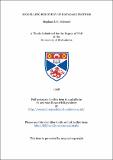Files in this item
Modelling recovery in database systems
Item metadata
| dc.contributor.advisor | Morrison, Ronald | |
| dc.contributor.author | Scheuerl, S. | |
| dc.coverage.spatial | 141 p. | en_US |
| dc.date.accessioned | 2018-05-23T08:44:40Z | |
| dc.date.available | 2018-05-23T08:44:40Z | |
| dc.date.issued | 1998 | |
| dc.identifier.uri | https://hdl.handle.net/10023/13482 | |
| dc.description.abstract | The execution of modern database applications requires the co-ordination of a number of components such as: the application itself, the DBMS, the operating system, the network and the platform. The interaction of these components makes understanding the overall behaviour of the application a complex task. As a result the effectiveness of optimisations are often difficult to predict. Three techniques commonly available to analyse system behaviour are empirical measurement, simulation-based analysis and analytical modelling. The ideal technique is one that provides accurate results at low cost. This thesis investigates the hypothesis that analytical modelling can be used to study the behaviour of DBMSs with sufficient accuracy. In particular the work focuses on a new model for costing recovery mechanisms called MaStA and determines if the model can be used effectively to guide the selection of mechanisms. To verify the effectiveness of the model a validation framework is developed. Database workloads are executed on the flexible Flask architecture on different platforms. Flask is designed to minimise the dependencies between DBMS components and is used in the framework to allow the same workloads to be executed on a various recovery mechanisms. Empirical analysis of executing the workloads is used to validate the assumptions about CPU, I/O and workload that underlie MaStA. Once validated, the utility of the model is illustrated by using it to select the mechanisms that provide optimum performance for given database applications. By showing that analytical modelling can be used in the selection of recovery mechanisms, the work presented makes a contribution towards a database architecture in which the implementation of all components may be selected to provide optimum performance. | en_US |
| dc.language.iso | en | en_US |
| dc.publisher | University of St Andrews | |
| dc.subject.lcc | QA76.9D3S3 | |
| dc.subject.lcc | Database management | en |
| dc.title | Modelling recovery in database systems | en_US |
| dc.type | Thesis | en_US |
| dc.type.qualificationlevel | Doctoral | en_US |
| dc.type.qualificationname | PhD Doctor of Philosophy | en_US |
| dc.publisher.institution | The University of St Andrews | en_US |
This item appears in the following Collection(s)
Items in the St Andrews Research Repository are protected by copyright, with all rights reserved, unless otherwise indicated.

